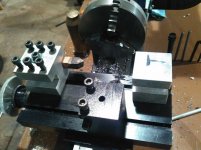Lou - N2MIY
Veteran Member
This thread is about the plastic piece that was used by DEC through the 70s to hold cover panels onto 19" racks. In the drawings and parts lists it is called the "Latch Molding". It seems to be of a design that is not so robust. Almost all of them I have ever seen have at least one ball and post broken off (http://www.vcfed.org/forum/album.php?albumid=410&attachmentid=45318). This is a link to a rendering that Vince has done of this part : http://svn.so-much-stuff.com/svn/trunk/3D/rack-bracket/bracket-screws.jpg . He also has .STL files for 3-D printing these, which I have done and discussed in an earlier thread. However, the way I have to orient the parts for my 3-d printer, the balls still break off.
I have come up with something more robust. I drilled and tapped a countersunk 8-32 hole centered where the original posts were. I then threaded in a flat head 1" long screw and put a sleeve of 6mm OD polyurethane tubing, cut to length, over it. (see here: http://www.vcfed.org/forum/album.php?albumid=410&attachmentid=45319 and http://www.vcfed.org/forum/album.php?albumid=410&attachmentid=45321) The balls were originally 1/4" OD to engage the holes in the back of the panels. There was somewhat of an interference fit, and panels needed to be pulled straight off so as not to break the posts. The plastic tubing offers friction to grab the holes in the panels and the steel screw is now a very strong post. This mod repair can be done for original brackets as well as newly 3-D printed ones. http://www.vcfed.org/forum/album.php?albumid=410&attachmentid=45322 I have more panels than brackets and so going forward I will 3-d print more of Vince's brackets and modify them with the steel screw post.
1/4" OD tubing is likely too large. I eyeballed the center of the old sticks before drilling (on a drill press) and so there is some locational error. The smaller (than 1/4") OD 6mm tubing allows some forgiveness across the four locations where the panel engages the tubing-covered posts. The 6mm tubing I have was used for factory automation pneumatic lines for connecting between solenoid valves and actuator gas cylinders (what I originally bought it for). It seems to be pretty common online. Of course the ID should fit tightly over the 8-32 screw, so it seems 4mm ID is best. Polyurethane is somewhat rubbery, and Tygon should be good, but polyethylene would be too stiff accommodate the misalignment.
The finished part looks fine and is very strong: http://www.vcfed.org/forum/album.php?albumid=410&attachmentid=45490 . They are holding on the panels in this picture quite securely http://www.vcfed.org/forum/album.php?albumid=43&attachmentid=45454 .
Lou
I have come up with something more robust. I drilled and tapped a countersunk 8-32 hole centered where the original posts were. I then threaded in a flat head 1" long screw and put a sleeve of 6mm OD polyurethane tubing, cut to length, over it. (see here: http://www.vcfed.org/forum/album.php?albumid=410&attachmentid=45319 and http://www.vcfed.org/forum/album.php?albumid=410&attachmentid=45321) The balls were originally 1/4" OD to engage the holes in the back of the panels. There was somewhat of an interference fit, and panels needed to be pulled straight off so as not to break the posts. The plastic tubing offers friction to grab the holes in the panels and the steel screw is now a very strong post. This mod repair can be done for original brackets as well as newly 3-D printed ones. http://www.vcfed.org/forum/album.php?albumid=410&attachmentid=45322 I have more panels than brackets and so going forward I will 3-d print more of Vince's brackets and modify them with the steel screw post.
1/4" OD tubing is likely too large. I eyeballed the center of the old sticks before drilling (on a drill press) and so there is some locational error. The smaller (than 1/4") OD 6mm tubing allows some forgiveness across the four locations where the panel engages the tubing-covered posts. The 6mm tubing I have was used for factory automation pneumatic lines for connecting between solenoid valves and actuator gas cylinders (what I originally bought it for). It seems to be pretty common online. Of course the ID should fit tightly over the 8-32 screw, so it seems 4mm ID is best. Polyurethane is somewhat rubbery, and Tygon should be good, but polyethylene would be too stiff accommodate the misalignment.
The finished part looks fine and is very strong: http://www.vcfed.org/forum/album.php?albumid=410&attachmentid=45490 . They are holding on the panels in this picture quite securely http://www.vcfed.org/forum/album.php?albumid=43&attachmentid=45454 .
Lou


